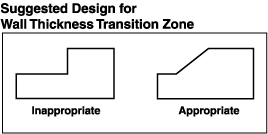For parts made from most thermoplastics, nominal wall thickness should not exceed 4.0 mm. Walls thicker than 4.0 mm will result in increased cycle times (due to the longer time required for cooling), will increase the likelihood of voids and significantly decrease the physical properties of the part. If a design requires wall thicknesses greater than the suggested limit of 4.0 mm, structural foam resins should be considered, even though additional processing technology would be required.
In general, a uniform wall thickness should be maintained throughout the part. If variations are necessary, avoid abrupt changes in thickness by the use of transition zones, as shown in the Suggested Design for Wall Thickness Transition Zone illustration. Transition zones will eliminate stress concentrations that can significantly reduce the impact strength of the part. Also, transition zones reduce the occurrence of sinks, voids, and warping in the molded parts.

A wall thickness variation of ±25% is acceptable in a part made with a thermoplastic having a shrinkage rate of less than 0.01 mm/mm. If the shrinkage rate exceeds 0.01 mm/mm, then a thickness variation of ±15% is permissible.